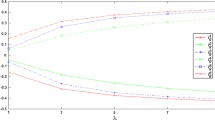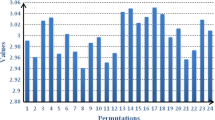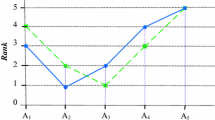Abstract
QUALIFLEX is a very efficient outranking method to handle multi-criteria decision-making (MCDM) involving cardinal and ordinal preference information. Based on a likelihood-based comparison approach, this paper develops two interval-valued hesitant fuzzy QUALIFLEX outranking methods to handle MCDM problems within the interval-valued hesitant fuzzy context. First, we define the likelihoods of interval-valued hesitant fuzzy preference relations that compare two interval-valued hesitant fuzzy elements (IVHFEs). Then, we propose the concepts of the concordance/discordance index, the weighted concordance/discordance index and the comprehensive concordance/discordance index. Moreover, an interval-valued hesitant fuzzy QUALIFLEX model is developed to solve MCDM problems where the evaluative ratings of the alternatives and the weights of the criteria take the form of IVHFEs. Additionally, this paper propounds another likelihood-based interval-valued hesitant fuzzy QUALIFLEX method to accommodate the IVHFEs’ evaluative ratings of alternatives and non-fuzzy criterion weights with incomplete information. Finally, a numerical example concerning the selection of green suppliers is provided to demonstrate the practicability of the proposed methods, and a comparison analysis is given to illustrate the advantages of the proposed methods.
Similar content being viewed by others
References
Atanassov K (1986) Intuitionistic fuzzy sets. Fuzzy Sets Syst 20(1):87–96
Atanassov K (1989) More on intuitionistic fuzzy sets. Fuzzy Sets Syst 33:37–46
Atanassov KT, Gargov G (1989) Interval-valued intuitionistic fuzzy sets. Fuzzy Sets Syst 31(3):343–349
Benayoun R, Roy B, Sussman N (1966) Manual de Reference du Program ELECTRE. Note de Synthese et Formation, Direction Scientifique SEMA, No. 25, Paris, 823 France
Chen TY (2013) Data construction process and qualiflex-based method for multiple-criteria group decision making with interval-valued intuitionistic fuzzy sets. Int J Inf Technol Decis Mak 12:425–467
Chen TY (2014) Interval-valued intuitionistic fuzzy QUALIFLEX method with a likelihood-based comparison approach for multiple criteria decision analysis. Inf Sci 261:149–169
Chen TY, Chang CH, Lu JFR (2013) The extended QUALIFLEX method for multiple criteria decision analysis based on interval type-2 fuzzy sets and applications to medical decision making. Eur J Oper Res 226:615–625
Chen TY, Tsui CW (2012) Intuitionistic fuzzy QUALIFLEX method for optimistic and pessimistic decision making. Adv Inf Sci Serv Sci 4(14):219–226
Chen TY, Wang JC (2009) Interval-valued fuzzy permutation method and experimental analysis on cardinal and ordinal evaluations. J Comput Syst Sci 75(7):371–387
Chen TY, Wang JC, Tsui CW (2007) Decision model with permutation methods based on intuitionistic fuzzy sets. In: Proceedings of the 8th Asia Pacific industrial engineering and management system and 2007 Chinese Institute of Industrial Engineers Conference (APIEMS and CIIE 2007), pp 243–250
Chen N, Xu ZS, Xia MM (2013) Interval-valued hesitant preference relations and their applications to group decision making. Knowl-Based Syst 37:528–540
Chen N, Xu ZS, Xia MM (2013) Correlation coefficients of hesitant fuzzy sets and their applications to clustering analysis. Appl Math Model 37(4):2197–2211
Dyer JS, Fishburn PC, Steuer RE, Wallenius J, Zionts S (1992) Multiple criteria decision making, multiattribute utility theory: the next ten years. Manag Sci 38:645–654
Dubois D, Prade H (1980) Fuzzy sets and systems: theory and applications. Academic Press, New York
Facchinetti G, Ricci RG, Muzzioli S (1998) Note on ranking fuzzy triangular numbers. Int J Intell Syst 13:613–622
Farhadinia B (2013) Information measures for hesitant fuzzy sets and interval-valued hesitant fuzzy sets. Inf Sci 240:129–144
Farhadinia B (2014) Correlation for dual hesitant fuzzy sets and dual interval-valued hesitant fuzzy sets. Int J Intell Syst 29:184–205
Griffith DA, Paelinck JHP (2011) Qualireg, a qualitative regression method. Adv Geogr Inf Sci 1(2):227–233
Hinloopen E, Nijkamp P, Rietveld P (2004) Integration of ordinal and cardinal information in multiple criteria ranking with imperfect compensation. Eur J Oper Res 158(2):317–338
Hokkanen J, Lahdelma R, Salminen P (2000) Multicriteria decision support in a technology competition for cleaning polluted soil in Helsinki. J Environ Manag 60(4):339–348
Hwang CL, Yoon K (1981) Multiple attribute decision making: methods and applications. Springer, Berlin
Lahdelma R, Miettinen K, Salminen P (2003) Ordinal criteria in stochastic multicriteria acceptability analysis (SMAA). Eur J Oper Res 147(1):117–127
Li DF (2011) Closeness coefficient based nonlinear programming method for interval-valued intuitionistic fuzzy multiattribute decision making with incomplete preference information. Appl Soft Comput 11(4):3402–3418
Li LG, Peng DH (2014) Interval-valued hesitant fuzzy Hamacher synergetic weighted aggregation operators and their application to shale gas areas selection. Math Probl Eng 2014:1–25
Martel JM, Matarazzo B (2005) Other outranking approaches. In: Figueira J, Greco S, Ehrgott M (eds) Multiple criteria decision analysis: state of the art surveys. Springer, New York, pp 197–262
Meng FY, Wang C, Chen XH, Zhang Q (2016) Correlation coefficients of interval-valued hesitant fuzzy sets and their application based on the Shapley function. Int J Intell Syst 31(1):17–43
Paelinck JHP (1976) Qualitative multiple criteria analysis, environmental protection and multiregional development. Pap Reg Sci Assoc 36(1):59–74
Paelinck JHP (1977) Qualitative multicriteria analysis: an application to airport location. Environ Plan 9(8):883–895
Paelinck JHP (1978) QUALIFLEX: a flexible multiple criteria method. Econ Lett 1(3):193–197
Park JH, Park IY, Kwun YC, Tan X (2011) Extension of the TOPSIS method for decision making problems under interval-valued intuitionistic fuzzy environment. Appl Math Model 35(5):2544–2556
Peng DH, Wang TD, Gao CY, Wang H (2014) Continuous hesitant fuzzy aggregation operators and their application to decision making under interval-valued hesitant fuzzy setting. Sci World J 2014:1–20
Quirós P, Alonso P, Bustince H, Díaz I, Montes S (2015) An entropy measure definition for finite interval-valued hesitant fuzzy sets. Knowl-Based Syst 84:121–133
Rebai A, Aouni B, Martel J-M (2006) A multi-attribute method for choosing among potential alternatives with ordinal evaluation. Eur J Oper Res 174(1):360–373
Roy B (1968) Classement et Choix en Presence de Points de vue Multiples (la method Electre). Revue Francaise d’Informatique et de Recherche Operationnelle 8:57–75
Roy B (1991) The outranking approach and the foundations of ELECTRE methods. Theory Decis 31:49–73
Sarabando P, Dias LC (2010) Simple procedures of choice in multicriteria problems without precise information about the alternatives’ values. Comput Oper Res 37(12):2239–2247
Shen L, Olfat L, Govindan K, Khodaverdi R, Diabat A (2013) A fuzzy multi criteria approach for evaluating green supplier’s performance in green supply chain with linguistic preferences. Resour Conserv Recycl 74:170–179
Stewart TJ (1992) A critical survey on the status of multiple criteria decision making theory and practice. Omega 20:569–586
Torra V (2010) Hesitant fuzzy sets. International Journal of Intelligent Systems 25:529–539
Torra V, Narukawa Y (2009) On hesitant fuzzy sets and decision. In: The 18th IEEE international conference on fuzzy systems, Jeju Island, Korea, 707, pp 1378–1382
Wang JC, Tsao CY, Chen TY (2015) A likelihood-based QUALIFLEX method with interval type-2 fuzzy sets for multiple criteria decision analysis. Soft Comput 19(8):2225–2243
Wang YM, Yang JB, Xu DL (2005) A two-stage logarithmic goal programming method for generating weights from interval comparison matrices. Fuzzy Sets Syst 152:475–498
Wei GW, Lin R, Wang HJ (2014) Distance and similarity measures for hesitant interval-valued fuzzy sets. J Intell Fuzzy Syst 27(1):19–36
Wei GW, Wang HJ, Lin R (2011) Application of correlation coefficient to interval-valued intuitionistic fuzzy multiple attribute decision-making with incomplete weight information. Knowl Inf Syst 26(2):337–349
Wei GW, Zhao XF (2013) Induced hesitant interval-valued fuzzy Einstein aggregation operators and their application to multiple attribute decision making. J Intell Fuzzy Syst 24(4):789–803
Wei GW, Zhao XF, Lin R (2013) Some hesitant interval-valued fuzzy aggregation operators and their applications to multiple attribute decision making. Knowl-Based Syst 46:43–53
Xia MM, Xu ZS (2011) Hesitant fuzzy information aggregation in decision making. Int J Approx Reason 52(3):395–407
Xu ZS, Chen J (2008) Some models for deriving the priority weights from interval fuzzy preference relations. Eur J Oper Res 184:266–280
Xu ZS, Da QL (2002) The uncertain OWA operator. Int J Intell Syst 17:569–575
Xu ZS, Zhang XL (2013) Hesitant fuzzy multi-attribute decision making based on TOPSIS with incomplete weight information. Knowl-Based Syst 52:53–64
Zadeh LA (1965) Fuzzy sets. Inf Control 8(3):338–353
Zadeh LA (1975) The concept of a linguistic variable and its application to approximate reasoning–I. Inf Sci 8:199–249
Zhang ZM, Wang C, Tian DZ, Li K (2014) Induced generalized hesitant fuzzy operators and their application to multiple attribute group decision making. Comput Ind Eng 67:116–138
Zhang ZM, Wu C (2014) Some interval-valued hesitant fuzzy aggregation operators based on Archimedean t-norm and t-conorm with their application in multi-criteria decision making. J Intell Fuzzy Syst 27(6):2737–2748
Zhang XL, Xu ZS (2015) Hesitant fuzzy QUALIFLEX approach with a signed distance-based comparison method for multiple criteria decision analysis. Expert Syst Appl 42(2):873–884
Zhu QH, Sarkis J (2004) Relationships between operational practices and performance among early adopters of green supply chain management practices in Chinese manufacturing enterprises. J Oper Manag 22:265–289
Zimmermann HJ, Zysno P (1980) Latent connectives in human decision making. Fuzzy Sets Syst 4(1):37–51
Acknowledgments
The author thanks the anonymous referees for their valuable suggestions in improving this paper. This work is supported by the National Natural Science Foundation of China (Grant No. 61375075) and the Natural Science Foundation of Hebei Province of China (Grant No. F2012201020).
Author information
Authors and Affiliations
Corresponding author
Rights and permissions
About this article
Cite this article
Zhang, Z. Multi-criteria decision-making using interval-valued hesitant fuzzy QUALIFLEX methods based on a likelihood-based comparison approach. Neural Comput & Applic 28, 1835–1854 (2017). https://doi.org/10.1007/s00521-015-2156-9
Received:
Accepted:
Published:
Issue Date:
DOI: https://doi.org/10.1007/s00521-015-2156-9




